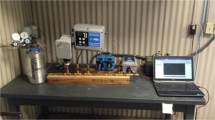Abstract
Purpose
In a potash mine in the center of Germany, stationary measurements 40 cm above ground level have revealed occasional increases in the carbon dioxide (CO2) levels that exceed the 0.5 vol.% German occupational exposure limit (OEL). This study, therefore, aimed to examine the individual exposures of potash miners to CO2 at their underground workplaces.
Methods
119 miners were equipped with personal CO2 detectors to log the individual CO2 exposures during underground work. We decided to use electrochemical monitors due to their compactness and minimal mass. Furthermore, generated CO2 measurements with precipitated overshooting and false positive CO2 values were studied using diverse CO2 test gases and different fumigation times.
Results
The personal detectors showed short-term CO2 peak exposures at very high concentrations in a limited number of workers. Twenty-two threshold limit value violations were observed according to the present OEL, and the personal CO2 monitoring allowed categorization into three exposure groups, low (n = 83), moderate (n = 26) and high burdens (n = 10) of CO2.
Conclusions
The electrochemical sensors used have numerous properties that can potentially influence the assessment of exposures. The current findings suggest that assessing similar exposure scenarios, with respect to elevated and strongly fluctuating CO2 concentrations, the behavior of electrochemical sensors should be taken into consideration.








Similar content being viewed by others
References
AMA: Aero Medical Association (1953) Committee on aviation toxicology, New York
Antony MM, Brown TA, Barlow DH (1997) Response to hyperventilation and 5.5% CO2 inhalation of subjects with types of specific phobia, panic disorder, or no mental disorder. Am J Psychiatry 154(8):1089–1095
Borum VF, Schaefer KE, Hastings BJ (1954) The effect of exposure to elevated carbon dioxide tension over a prolonged period on basal physiological functions and cardiovascular capacity. US Navy Med Res Lab Rep 241:1–19
Craig FN (1971) Technical Report No. N72-14127-1970. AFSC, Wright-Patterson AFB, Ohio
Dahmann D, Monz C, Sönksen H (2007) Exposure assessment in German potash mining. Int Arch Occup Environ Health 81(1):95–107
DFG (1961) The MAK collection for occupational health and safety, Online ISBN: 9783527600410, 9th edn. Wiley VCH Weinheim
DFG (2002) The MAK collection for occupational health and safety, Online ISBN: 9783527600410, 34th edn. Wiley VCH Weinheim
Dräger Safety AG and Co. KGaA (2011) Dräger sensor and handbook of gas measurement devices (in German), http://www.draeger.com/media/10/04/22/10042231/sensorhandbuch_br_9046570_de.pdf
Duchrow G, Thoma K, Marggraf P, Sanzer K (1988) Forschungen zum Phänomen der Salz-Gas-Ausbrüche im Werra-Kaligebiet der DDR (Research on the phenomenon of the salt-gas eruptions in the Werra potash area in the GDR). Neue Bergbautechnik 18:241–250 (in German)
Ebersole JH (1960) The new dimensions of submarine medicine. N Engl J Med 262:599–610
Flury F, Zernik F (1931) Schädliche Gase und Dämpfe. Springer, Berlin
DFG (Deutsche Forschungsgemeinschaft) (2011) List of MAK and BAT values 2011, commission for the investigation of health hazards of chemical compounds in the work area, report no. 47, Wiley VCH Weinheim
Gray SP (1950) Pulmonary ventilation and its physiologic regulation. Chas. Thomas Pub., Springfield, IL
Kleinhanß G, Piekarski C, Seebaß M, Gorges W (1985) Ergonomische Aspekte zur Optimierung der Versorgung von Schutzräumen mit Atemluft in Notsituationen. Teil 1: theoretische Grundlagen (ergonomical aspects of the optimization of the maintenance of protective rooms with breath air in emergency situations. Part 1: theoretical bases). Wehrmed Mschr 3:91–107
Kutz A, Marshall E, Bernstein A, Zvolensky MJ (2010) Evaluating emotional sensitivity and tolerance factors in the prediction of panic-relevant responding to a biological challenge. J Anxiety Disord 24:16–22
Langford NJ (2005) Carbon dioxide poisoning. Toxicol Rev 24(4):229–235
Love RE, Wuir DCF, Sweetland KF (1979) Tolerance and ventilatory response to inhaled CO2 during exercise and with inspiratory resistive loading. Ann Occup Hyg 22:43–53
NIOSH: National institute for occupational safety and health (2009) http://www.cdc.gov/niosh-rtecs/FF61A800.html
Ogliari A, Tambs K, Harris JR, Scaini S, Maffei C, Reichborn-Kjennerud T, Battaglia M (2010) The relationships between adverse events, early antecedents, and carbon dioxide reactivity as an intermediate phenotype of panic disorder. Psychother Psychosom 79:48–55
Schaefer KE, Hastings BJ, Carey CR, Nichols G (1963) Respiratory acclimatization to carbon dioxide. J Appl Physiol 18:1071
Stegen K, Neujens A, Crombez G, Hermans D, Van de Woestijne KP, Van den Bergh O (1998) Negative affect, respiratory reactivity and somatic complaints in a CO2 enriched air inhalation paradigm. Biol Psychol 49:109–122
TRGS 900 (2006) Technical rules for hazardous substances, Federal institute for occupational safety and health (BAuA)
Wenzel J, Luks N, Plath G, Wilke D, Gerzer R (1998) Part one: the influence of CO2 in a space-like environment: study design. Aviat Space Environ Med 69(3):285–290
Zosel J, Oelßner W, Decker M, Gerlach G, Guth U (2011) The measurement of dissolved and gaseous carbon dioxide concentration. Meas Sci Technol 22:072001
Conflict of interest
The authors report no conflicts of interest.
Author information
Authors and Affiliations
Corresponding author
Rights and permissions
About this article
Cite this article
Monsé, C., Broding, H.C., Sucker, K. et al. Exposure assessment of potash miners at elevated CO2 levels. Int Arch Occup Environ Health 87, 413–421 (2014). https://doi.org/10.1007/s00420-013-0880-y
Received:
Accepted:
Published:
Issue Date:
DOI: https://doi.org/10.1007/s00420-013-0880-y




